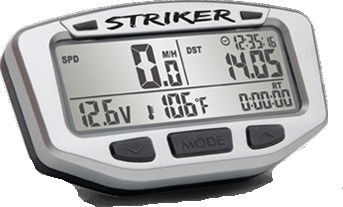
An introduction to accurate rollchart enjoyment
By Tom Niemela,
Over the years I have been to many dualsport events and have been laying out dualsport events for over three decades. The accuracy of an event's rollcharts allows riders to enjoy the ride more with less chance of getting lost or frustrated. There are two, basic requirements for creating/using accurate rollcharts:
1: A resettable odometer. No, not just one that resets to zero, but one that you can manually change the mileage values up or down, especially when you can get down to 1/100ths of a mile.
2: The ability to calibrate wheel size. Most stock odometers do not have this option, so most riders are stuck with the default value that is integral to their factory unit. Your accuracy changes as your tire wears with each new or worn front tire. There are some bikes that you actually CAN recalibrate wheel size (like KTMs), but you do have to jump through a few hoops to facilitate this.
So you say you do not have an odometer that you can manually adjust forward or backwards, and it only resets to zero, and/or you cannot adjust wheel size? There is a simple solution to this dilemma: an enduro computer. There are many out there that you can get like ICO's Enduro Computer or even older ICO units and even the Moose Pacemaker Computers. These are all good and will do the two needed features listed above. There is also one more option offered by our friends at a Northwest company called Trail Tech (www.trailtech.net). They offer numerous, economical digital computers for your bike, but only one of their current units allows you to show/adjust by 1/100th of a mile, plus allow wheel-size adjustments - this is their Striker Computer. Their previous Endurance and Vector Computers also allowed you the two, above features, but for some reason this feature fell by the wayside on the newer models except for their Striker. Fortunately the Striker still allows a savvy dualsporter to both reset mileages forward or back in 1/100th of a mile, AND calibrate wheel size.

Installing one of these units on your motorbike is relatively easy and they come with detailed instructions. Of course they do many other cool things, but we are only concerned about the two listed items above.
Okay, now you've got your computer installed - now what? Easy, simply calibrate your wheel size like this:
* Make sure you have proper inflation of your front tire. I suggest a minimum of 13psi. 15psi for higher speeds or desert. Use ONLY an accurate air-pressure gauge, like one that maxes out to 20psi.
* Get some white tooth paste, a tape measure and a flat, smooth surface like cement.
* Add a blob of toothpaste on a middle knob of your front tire.
* Roll your bike backwards in a straight line, so the toothpaste leaves a knobby impression on the cement.
* When the knob of tooth paste comes up again, add another blob of tooth paste.
* Keep rolling your bike backwards so the knob makes a second blob on the cement. Now move your bike out of the way.
* With your tape measure (and perhaps another person to help with the tape), measure the front of the first knob imprint to the front of the second knob imprint. You will see a distance of around 84 inches or so. Let's use 84 inches for the sake of this process.
* You will now need to convert inches to millimeters for the computer, so multiply 84 inches by 25.4 to make the conversion. 84 x 25.4 = 2133.6 millimeters.
* Now go into the setup of your computer and enter in that value in the wheel size configuration. I normally round down, so enter in 2133 millimeters.
Voila! You now have the proper wheel size! You are now as accurate as possible. This is what we do daily to lay out our events, so we ALWAYS have an accurate measurement, which is what you've come to expect. We suggest you do the same, so your mileage will be extremely close to our rollcharts - generally within a mere 1/100th of a mile. You now have the optimum setup, so you can be extremely close in calibration to our rollcharts, PLUS if you blow a turn, you can simply go back to the last known turn on the rollchart and reset to the exact mileage and continue on - no more trying to calibrate in your head if your odometer is off! When we lay out our events, we almost always stay to the right around every turn. If you do not do that (and risk a head on), your mileage may vary.
And for you clubs that also host dualsport events, we highly suggest this method so your rollcharts are more accurate also - this is the optimum setup. You owe it to the riders at your event to always be as accurate as possible. Once a rider properly does this process, it's extremely easy to see when more than one bike laid out a course, as the rollchart mileages suddenly change drastically, hence clubs should have only ONE bike do mileages for their courses. Either that, or ensure all bikes were calibrated properly.
Ride on and enjoy much easier and enjoyable dualsporting!
-Tom